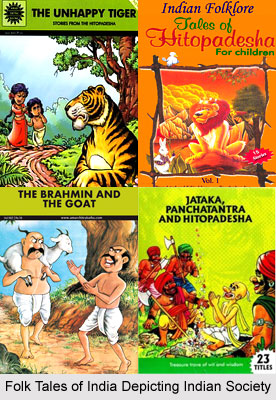Indian Society in Folk Tales of India lays bare the enchanting collection of stories in several languages which by turns are harrowing and comic, sardonic and allegorical, mysterious and romantic. Gods disguised as beggars and beasts; animals enacting Machiavellian intrigues: sagacious jesters and magical storytellers; wise counsellors and foolish kings all of these inhabit a fabulous world, yet one firmly grounded in everyday life. The two most important collections within this fairy-tale Sanskrit literature framework are Panchatantra and Hitopadesha. During its initiation, they were strictly designated as manuals to instruct the kings in domestic and foreign policies.
 Panchatantra and Hitopadesha belong to that class of literature which the Hindus refer to as niti-sastra, or "Science of Political Ethics". Other noteworthy prose works in Sanskrit literature comprise a collection of pretty and nifty fairy tales, inclined towards being touted as doused with much of Oriental emblazoning. The Vetala-panchavimsati or "Twenty-five Tales of the Vetal" (a demon reckoned to possess corpses), the Simhasana-dvatrimcika or "Thirty-two Stories of the Lion-seat" (i.e. throne), which also are also much popular by the name of Vikrama-charita, or "Adventures of Vikrama" and the "Seventy Stories of a Parrot" absolutely fall under this category. These three compilations of fairy tales have all been penned in prose and are relatively short as compared to other scholarly treatises in Sanskrit literary works. Somadeva `s Katha-sarit-sagara or "Ocean of Rivers of Stories" commands attention of special importance, having been authored in verse and also maintaining an equal substantial size. The Sanskritic fable comprises more than 22,000 shlokas, corresponding to nearly one-fourth of the Mahabharata. The Panchatantra is one book which clearly demarcates the Indian society in the contemporary genre and is viewed as a popular reflecting mirror for the Indian populace and the sociologists for the ages to come.
Panchatantra and Hitopadesha belong to that class of literature which the Hindus refer to as niti-sastra, or "Science of Political Ethics". Other noteworthy prose works in Sanskrit literature comprise a collection of pretty and nifty fairy tales, inclined towards being touted as doused with much of Oriental emblazoning. The Vetala-panchavimsati or "Twenty-five Tales of the Vetal" (a demon reckoned to possess corpses), the Simhasana-dvatrimcika or "Thirty-two Stories of the Lion-seat" (i.e. throne), which also are also much popular by the name of Vikrama-charita, or "Adventures of Vikrama" and the "Seventy Stories of a Parrot" absolutely fall under this category. These three compilations of fairy tales have all been penned in prose and are relatively short as compared to other scholarly treatises in Sanskrit literary works. Somadeva `s Katha-sarit-sagara or "Ocean of Rivers of Stories" commands attention of special importance, having been authored in verse and also maintaining an equal substantial size. The Sanskritic fable comprises more than 22,000 shlokas, corresponding to nearly one-fourth of the Mahabharata. The Panchatantra is one book which clearly demarcates the Indian society in the contemporary genre and is viewed as a popular reflecting mirror for the Indian populace and the sociologists for the ages to come.
Fable collections, initially functioning as the handbooks of `practical moral philosophy`, rendered a luxuriant resource of ethical dictums, that become so popular, that works comprising exclusively poetical aphorisms began to flood the literary domain. The most important amongst this bunch of Sanskrit literature are the two collections by the exceedingly-talented Bhartrhari, titled respectively or "Century of Conduct," and Vairagya ataka, translated into English as "Century of Renunciation". The principal and persisting theme in these works and in the new ethical poetry style, is the doctrine of vanity of human life, which had germinated before the ascension of Buddhism during the sixth century B.C., and has since, reigned over Indian thought process.
Tall Tales of Vishnu Sharma
Panchatantra is a graphically illustrated Indian comics series, which is published and distributed in India and globally by Liquid Indian Comics, which was originally established as Virgin Comics. It is a five issue limited comic book mini-series which is inspired by the many tales in the Panchatantra, a collection of ancient Indian animal fables. The comics` series of Tall Tales of Vishnu Sharma: Panchatantra is created by writer Samit Basu and illustrated by artist Ashish Padlekar. The comics are about a typical Indian teenage nerd named Vishnu Sharma who enjoys playing Role Playing Games (RPGs) and other such stuffs. Although his grandfather has gifted him ancient copy of the Panchatantra right before his death, but he finds no interest in the ancient Indian fable. But unfortunately, he discovers he is assigned as the new guardian of the Panchatantra itself.



















